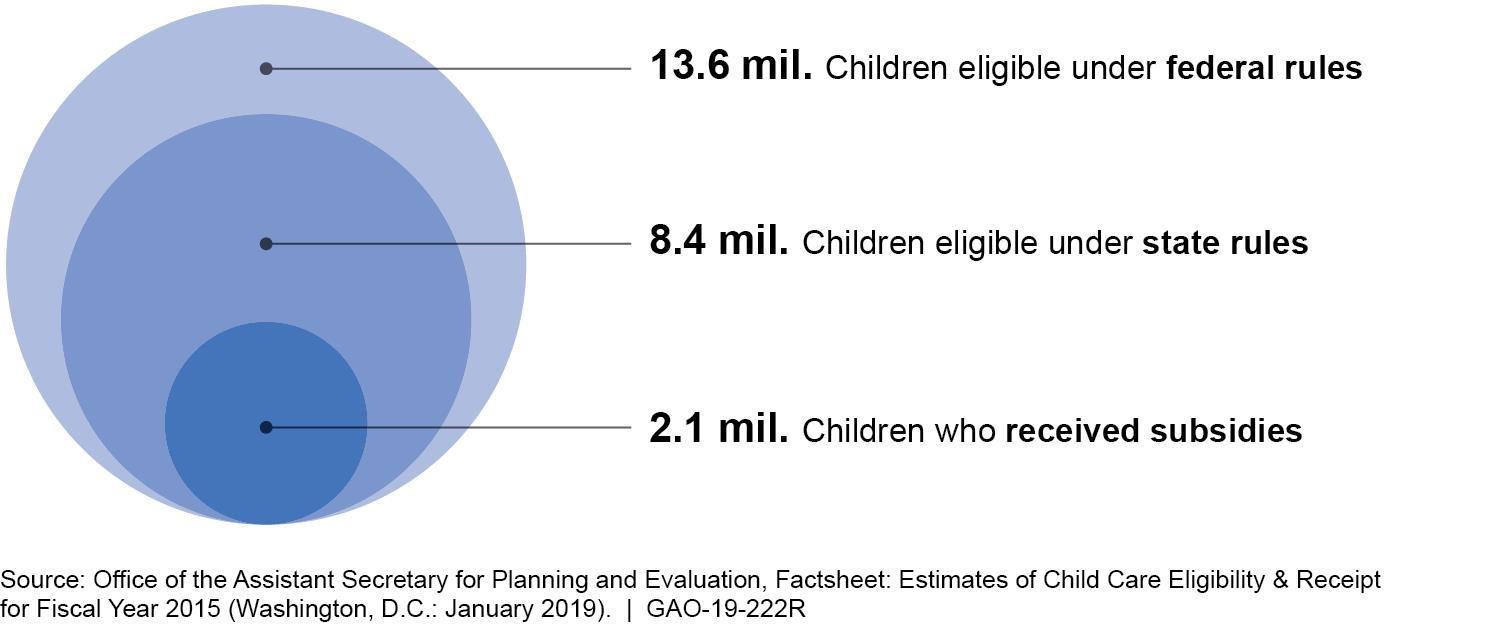Child Care and Development Fund: Subsidy Receipt and Plans for New Funds
Fast Facts
A federal fund helps low-income families pay for child care while parents work or attend school. We've previously reported that states manage the high demand for these child care subsidies in various ways, including lowering income limits for eligibility and using wait lists.
In 2018, Congress appropriated $5.2 billion for the fund—nearly twice the amount of the prior year. States have various plans for that money, such as raising payment rates for child care providers and taking children off of wait lists. However, some states hesitated to make plans because it's unclear whether the funding will continue at this level going forward.
Estimated Number of Children Eligible for and Receiving Child Care Subsidies, FY 2015

Concentric circles show about 2 million kids got subsidies out of 8 million state-eligible and 14 million federally-eligible.
Highlights
What GAO Found
An estimated one-quarter of children eligible for child care subsidies under state eligibility rules received them (2.1 million of the 8.4 million children in an average month estimated to be eligible under state rules), according to the Department of Health and Human Services' (HHS) analysis of data from fiscal year 2015, the most recent year for which such analysis is available. This represented 15 percent of all children estimated to be eligible under federal rules, as generally, fewer families qualify for subsidies under state eligibility rules than under federal eligibility rules since most states use flexibility provided by HHS to set their income eligibility limits below the federal maximum.
Health and Human Services’ Estimated Number of Children Eligible Under Federal and State Rules and Estimated Number Receiving Child Care Subsidies, Fiscal Year 2015

HHS also estimated that, among families who met federal eligibility criteria, children from lower-income families were more likely to receive child care subsidies compared to children from higher-income families. These estimates also showed that preschool-aged children were more likely to receive subsidies compared to older, school-aged children. For example, 45 percent of 5-year-old children from families with incomes below the federal poverty line received subsidies, while 11 percent of 5-year-olds with family incomes between 150 and 199 percent of poverty received subsidies. Additionally, 51 percent of 3-year-olds from families with incomes below the federal poverty line received subsidies, while 29 percent of 6- to 9-year-old children with family incomes below the poverty line received subsidies.
In GAO's survey of 51 state Child Care and Development Fund (CCDF) administrators, almost all states (44) reported they expect to spend the new discretionary CCDF funding from the Consolidated Appropriations Act, 2018, on at least one of several state child care activities related to requirements of the Child Care and Development Block Grant Act of 1990, as amended (CCDBG Act). The most frequently reported activities were spending toward child care provider payment rates and parental copayments, professional development of the child care workforce, and consumer education. For example, under the CCDBG Act, states must certify that their child care provider payment rates are sufficient to ensure that children eligible for subsidies have the same access to child care services as children who are not eligible for CCDF subsidies. Officials in two states told GAO the state plans to use these funds to increase payment rates for subsidized child care providers who provide nighttime and weekend care, in an effort to promote access to child care for families with nontraditional work hours. Three-quarters of states GAO surveyed (38) also reported they expect to spend the new funds on at least one additional state child care activity that is not explicitly required. The activities most frequently cited were spending on a tiered quality rating system, child care resource and referral system, and for quality activities beyond the required minimum. In addition, nearly one-third of states (16) reported in GAO's survey that they plan to use new CCDF funds to pay for subsidies for children on their wait lists to receive child care. States may use a wait list when they do not have sufficient CCDF funds to provide subsidies to all eligible families that apply. However, some state CCDF administrators expressed uncertainty about their states' plans for using the new CCDF funds. For example, officials in more than one-third of states GAO interviewed (6) said they were still in the process of deciding how to spend the new funds.
Why GAO Did This Study
The federal child care subsidy program known as CCDF is the primary source of federal funding dedicated to assisting low-income families who are working or participating in education and training by increasing their access to quality child care. Discretionary funding for CCDF, which is administered by HHS, is authorized by the CCDBG Act. The Act also includes various requirements for states, including spending a minimum amount on activities designed to improve the quality of child care services. In March 2018, the Consolidated Appropriations Act, 2018 was enacted, which provided $5.2 billion in discretionary CCDF funding for fiscal year 2018, approximately twice the amount provided in fiscal year 2017.
The CCDBG Act of 2014 included a provision for GAO to review every 2 years the number of families eligible to receive assistance under the CCDBG Act, as well as those who have applied for assistance and those who have been placed on a wait list for assistance. To address this provision, this report describes (1) what is known from the most recent data available from HHS about the extent to which eligible children received child care subsidies and their characteristics, and (2) how states plan to use the increase in CCDF funding from the Consolidated Appropriations Act, 2018, including addressing wait lists.
Recommendations
GAO is not making any recommendations.
